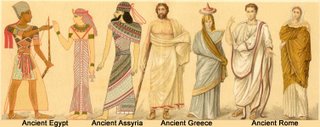
Ancient Roman Dress

Roman dress at first glance appears to be identical to Greek dress in it's draperies and design. Closer inspection, however, reveals many important changes. First, the basic garments are sew
 n, not pinned, and close on both sides. Second, elaborate fabric decoration nearly disappears, and bold patterns on garments are nonexistent. Sandals, boots and shoes are common, virtually all men wear them, and many women. Jewelry becomes so simple in design and execution it looks crude, even without the comparison of the fine Greek work standing in contrast to it.
n, not pinned, and close on both sides. Second, elaborate fabric decoration nearly disappears, and bold patterns on garments are nonexistent. Sandals, boots and shoes are common, virtually all men wear them, and many women. Jewelry becomes so simple in design and execution it looks crude, even without the comparison of the fine Greek work standing in contrast to it.Roman Jewelry

Contrary to the views engendered by sensational fiction such as Bulwer Lytton's "Last Days of Pompeii" or the wondrous silliness of "Gladiator Movies", Romans were, by and large, the kind of practical, upright, uptight folks who believed in civil service, interstate highways, and customs duties. Their clothing included the Tunica (which is, as you have already guessed, a simple t-tunic), the Stola (the female version of the same thing), the Toga (a extra long half-circle wool mantle worn by male citizens) and the Palla, a large, long (8 yard) drape or scarf worn by women outdoors.
Sartorial decadence, such as it was, centered around women's hairstyles which changed fashion regularly and were often elaborately silly

No comments:
Post a Comment